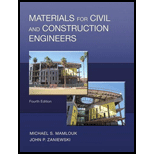
Pearson eText for Materials for Civil and Construction Engineers -- Instant Access (Pearson+)
4th Edition
ISBN: 9780137505586
Author: Michael Mamlouk, John Zaniewski
Publisher: PEARSON+
expand_more
expand_more
format_list_bulleted
Concept explainers
Question
Chapter 9, Problem 9.1QP
To determine
Write the difference between tar and asphalt cement.
Expert Solution & Answer
Explanation of Solution
Difference between tar and asphalt cement as in Table (1):
| Asphalt cement | Tar |
| Asphalt occurs in natural form or by means of a by-product of petroleum refinery. It is sticky, adhesive, elastic, and easily able to stretch flex and bend without breaking. | Tar cannot occur in natural form; it is obtained as a by-product when manufacturing water-gas and coke. |
| Asphalt is more weather resistant. | Tar is more temperature susceptible, usually used to coat aggregates that are more water resistant. |
| Hot mix paving asphalt creates odor that can be strong and persistent. | Tar has an aromatic odor. |
| Asphalt molecules tend to be aliphatic (referred as a straight chain). | Tar tends to be aromatic (referred as cyclic or ring). |
| Asphalt fume causes health hazards such as skin rash, fatigue, headache, and also skin cancer. | Fumes from the heated tar cause health hazards to human beings such as severe eye and skin irritation. |
|
Uses: They are largely used for pavement construction and maintenance. It is used as glue with aggregate particles to create the asphalt concrete. |
Uses: They are broadly used in road works because it is superior and also used for preserving timber. |
Want to see more full solutions like this?
Subscribe now to access step-by-step solutions to millions of textbook problems written by subject matter experts!
Students have asked these similar questions
Civil engineering quanti
Please answer the questions in the picture. Thank you for your help. For part B use the Second Picture.
Derive by deconvolution the six-hour unit hydrograph from the following data for a watershed having a drainage area of 216 km2 , assuming a constant rainfall abstraction rate and a constant baseflow of 20 m3 /s. Six-hour period 1 2 3 4 5 6 7 8 9 10 11 Rainfall (cm) 1.5 3.5 2.5 1.5 Streamflow (m3 /s) 26 71 174 226 173 99 49 33 26 22 21 Use the unit hydrograph developed to calculate the streamflow hydrographfrom a 12 hour-duration storm having 2 cm of rainfall excess in the first six hours and 3 cm inthe second six hours. Assume a constant baseflow rate of 30 m3/s.
Chapter 9 Solutions
Pearson eText for Materials for Civil and Construction Engineers -- Instant Access (Pearson+)
Ch. 9 - Prob. 9.1QPCh. 9 - Prob. 9.2QPCh. 9 - Prob. 9.3QPCh. 9 - Prob. 9.4QPCh. 9 - Prob. 9.5QPCh. 9 - Prob. 9.6QPCh. 9 - Prob. 9.7QPCh. 9 - What are the engineering applications of each of...Ch. 9 - Prob. 9.9QPCh. 9 - Prob. 9.10QP
Ch. 9 - Prob. 9.11QPCh. 9 - Prob. 9.12QPCh. 9 - Prob. 9.13QPCh. 9 - Prob. 9.14QPCh. 9 - Prob. 9.15QPCh. 9 - Prob. 9.16QPCh. 9 - Prob. 9.17QPCh. 9 - Prob. 9.18QPCh. 9 - What are the objectives of the asphalt concrete...Ch. 9 - Prob. 9.20QPCh. 9 - Prob. 9.21QPCh. 9 - Prob. 9.22QPCh. 9 - Prob. 9.23QPCh. 9 - Prob. 9.24QPCh. 9 - Prob. 9.25QPCh. 9 - An asphalt concrete mixture includes 94% aggregate...Ch. 9 - Prob. 9.27QPCh. 9 - Prob. 9.28QPCh. 9 - Prob. 9.29QPCh. 9 - Prob. 9.30QPCh. 9 - Based on the data shown in Table P9.31, select the...Ch. 9 - Based on the data in Table P9.32, determine the...Ch. 9 - Given the data in Table P9.33, select the blend...Ch. 9 - The Marshall method of mix design has been widely...Ch. 9 - Prob. 9.35QPCh. 9 - Prob. 9.36QPCh. 9 - Prob. 9.37QPCh. 9 - Prob. 9.38QPCh. 9 - Prob. 9.39QPCh. 9 - Prob. 9.40QPCh. 9 - Prob. 9.41QPCh. 9 - Prob. 9.42QPCh. 9 - Prob. 9.43QPCh. 9 - What is the purpose of adding fly ash to asphalt...Ch. 9 - Prob. 9.45QPCh. 9 - Prob. 9.47QPCh. 9 - Prob. 9.48QP
Knowledge Booster
Learn more about
Need a deep-dive on the concept behind this application? Look no further. Learn more about this topic, civil-engineering and related others by exploring similar questions and additional content below.Similar questions
- Please answer the following question in the picture. Thank you for your help.arrow_forwardGiven the unit hydrographic in the table, calculate the streamdlow hydrographic from a 12 hour duration story having 2cm of rainfall excess in the first six hours and 3cm in the second six hours. Assume a constant base flow rate of 30 m3/sarrow_forwardBased on the following information, what is the owner’s equity? Current Assets: $162,000Current Liabilities: $91,000 Fixed Assets: $290,000 long-Term Debt: $140,000arrow_forward
- Please refer to the below figure. Use f y = 60,000 psi and f c′ = 3000 psi. Each web is reinforced with 2-#4 rebars in one layer. (a) Use the entire flange width as effective. Determine if the interior Double-Tee beam behaves as a T-beam or rectangular beam. (b) Determine the design moment strength of the section. Hint: You can collapse the two webs in a single web as discussed in class.arrow_forwardGrade is being established to the bottom of a footing that is 24” thick. The elevation of thetop of the footing is 102.33’. the elevation of the existing grade is 106.14’. the backsight of thesurveying instrument on a benchmark of 100.00’ is 6.78’. what is the correct reading for the rodat the bottom of the footing?arrow_forward6.48 This "double" nozzle discharges water (p = 62.4 lbm/ft³) into the atmosphere at a rate of 16 cfs. If the nozzle is lying in a horizontal plane, what X-component of force acting through the flange bolts is required to hold the nozzle in place? Note: Assume irrotational flow, and assume the water speed in each jet to be the same. Jet A is 4 in. in diameter, jet B is 4.5 in. in diameter, and the pipe is 1.4 ft in diameter. A 30°F B Problem 6.48 Xxarrow_forward
- 6-1 For the rectangular beam shown in Fig. P6-1, (a) Draw a shear-force diagram. (b) Assuming the beam is uncracked, show the direction of the principal tensile stresses at middepth at points A, B, and C. (c) Sketch, on a drawing of the beam, the inclined cracks that would develop at A, B, and C. 10 kips A B 1 kip/ft 7.5 ft Fig. P6-1 + 7.5 ft 6 ft 10 kipsarrow_forward6.85 A reducing pipe bend is held in place by a pedestal as shown. There are expansion joints at sections 1 and 2, so no force is transmitted through the pipe past these sections. The pressure at section 1 is 20 psig, and the rate of flow of water (p = 62.4 Ibm/ft³) is 2 cfs. Find the force and moment that must be applied at section 3 to hold the bend stationary. Assume the flow is irrotational, and neglect the influence of gravity. 6 in. diameter + 24 in. 24 in. (3 4 in. diameter Problem 6.85arrow_forward6.79 A cart is moving along a railroad track at a constant velocity of 5 m/s as shown. Water (p = 1000 kg/m³) issues from a nozzle at 10 m/s and is deflected through 180° by a vane on the cart. The cross-sectional area of the nozzle is 0.002 m². Calculate the resistive force on the cart. 5 m/s D 10 m/s Nozzle Problem 6.79arrow_forward
- Oil of specific gravity 0.800 acts on a vertical triangular area whose apex is in the oil surface. The triangle is 9 ft high and 12 ft wide. A vertical rectangular area 8 ft high is attached to the 12-ft base of the triangle and is acted upon by water. Find the magnitude and position of the resultant force on the entire area.arrow_forwardWhat types of constraints did Covid-19 cause in duration of activities on different construction projects?arrow_forwardPost-tensioned AASHTO Type III girders are to be used to support a deck with unsupported span equal to 90 feet. One level of Grade 270, 10 x 0.6" Ø 7-wire strand are used to tension the girders. The girder is simply supported at both ends. The anchors are located 2" from the neutral axis at the supports while the eccentricity is measured at 14" at the midspan. Use maximum values for ranges (table values). The tendons are encased in flexible metal sheathing. Assume and loadings are placed immediately after stressing. Determine the stresses at the top and bottom of the beam, including the stress at the level of steel after three years. Given the following parameters: F'c = 5000 psi Fy = 240 ksi (Bonded, Stress-relieved) Fu = 270 ksi = Es 29,000 ksi Ec = 4,030 psi Fj = 235 ksi A = 1x0.6" 07-W.S. = 0.217 in² Yc = 140 lbs/ft³ ΔΑ = 3/8" RH = 33% Superimposed Service Load = 10 kips/ft (excluding self-weight)arrow_forward
arrow_back_ios
SEE MORE QUESTIONS
arrow_forward_ios
Recommended textbooks for you
 Traffic and Highway EngineeringCivil EngineeringISBN:9781305156241Author:Garber, Nicholas J.Publisher:Cengage Learning
Traffic and Highway EngineeringCivil EngineeringISBN:9781305156241Author:Garber, Nicholas J.Publisher:Cengage Learning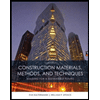 Construction Materials, Methods and Techniques (M...Civil EngineeringISBN:9781305086272Author:William P. Spence, Eva KultermannPublisher:Cengage Learning
Construction Materials, Methods and Techniques (M...Civil EngineeringISBN:9781305086272Author:William P. Spence, Eva KultermannPublisher:Cengage Learning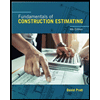 Fundamentals Of Construction EstimatingCivil EngineeringISBN:9781337399395Author:Pratt, David J.Publisher:Cengage,
Fundamentals Of Construction EstimatingCivil EngineeringISBN:9781337399395Author:Pratt, David J.Publisher:Cengage,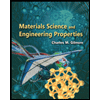 Materials Science And Engineering PropertiesCivil EngineeringISBN:9781111988609Author:Charles GilmorePublisher:Cengage Learning
Materials Science And Engineering PropertiesCivil EngineeringISBN:9781111988609Author:Charles GilmorePublisher:Cengage Learning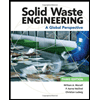 Solid Waste EngineeringCivil EngineeringISBN:9781305635203Author:Worrell, William A.Publisher:Cengage Learning,
Solid Waste EngineeringCivil EngineeringISBN:9781305635203Author:Worrell, William A.Publisher:Cengage Learning,

Traffic and Highway Engineering
Civil Engineering
ISBN:9781305156241
Author:Garber, Nicholas J.
Publisher:Cengage Learning

Construction Materials, Methods and Techniques (M...
Civil Engineering
ISBN:9781305086272
Author:William P. Spence, Eva Kultermann
Publisher:Cengage Learning

Fundamentals Of Construction Estimating
Civil Engineering
ISBN:9781337399395
Author:Pratt, David J.
Publisher:Cengage,

Materials Science And Engineering Properties
Civil Engineering
ISBN:9781111988609
Author:Charles Gilmore
Publisher:Cengage Learning

Solid Waste Engineering
Civil Engineering
ISBN:9781305635203
Author:Worrell, William A.
Publisher:Cengage Learning,